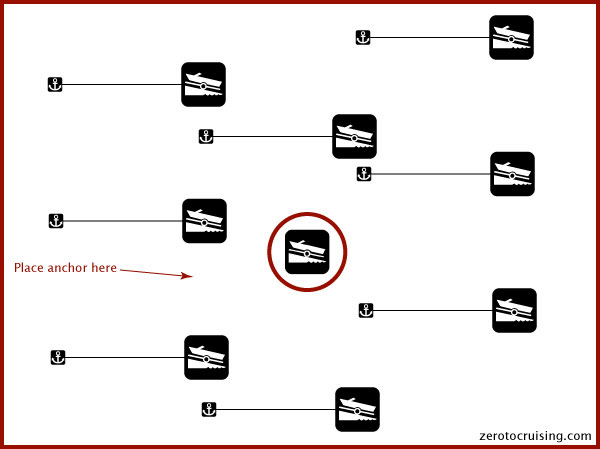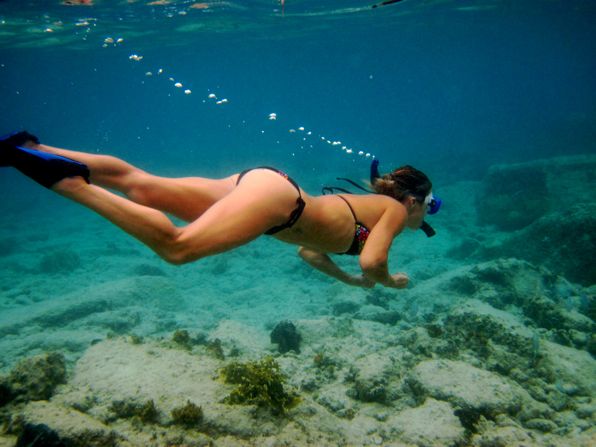The anchor drill
Anchoring a boat. How hard can it be? In truth, although others seem to have great challenges with it, we seldom find it all that difficult. But there is a whole series of steps that we go through though to make sure that we sleep soundly. Take yesterday for example. After breakfast, blogging, workouts and all the other morning stuff that we spend time on, we raised anchor to motor inside the Rodney Bay lagoon to top up on fuel. I don’t know why it happens but lately the wind always seems to kick up above 15 knots whenever we think about docking. Luck must have been with us though because we slid our boat alongside the fuel dock like pros who live in marinas, which of course, couldn’t be farther from the truth. With sufficient gas on board to get us to Grenada, and then some, we motored back out into the bay to acquire a similar anchor spot to the one that we had recently left. This is when the “fun” started.
Our process for anchoring goes like this. The first step is to look at the currently anchored boats and pick out a spot that, after you have let out sufficient rode, will not place you too close to another vessel. Some people have a lot of difficulty with this. Perhaps it’s a spatial awareness thing, I don’t know. This anchorage was not at all crowded though so the process was easy. The charts also showed that the water remains quite deep right up close to the shore so we just moved to the front of the pack to grab our spot.

With Rebecca at the helm and me on the bow, we motor into our selected spot with her calling out the depths as we move. Knowing the depth that you are anchoring in is important as you must let out a sufficient amount of anchor rode to get the angle right. The ratio of the water’s depth to the length of anchor rode (chain, rope or a combination of the two) is called “scope.” A good figure for scope for anchoring overnight is 7:1. If the anchorage is crowded, we’ll settle for 5:1, but only if we have to. An important detail to take into consideration when calculating this is the boat’s “freeboard.” Freeboard is the measurement from the surface of the water to the deck. If you base your calculations for scope solely on the water’s depth, what your depth meter might show, without taking into account that the rode’s attachment point is quite a bit higher, in our case 3 feet higher, you won’t really have 7:1 out as you might think.
Anyway, let’s assume that we have that all figured out. After setting the anchor on the bottom, we’ll either let the boat drift back in strong winds or current or without that, we’ll motor slowly backwards, paying out the anchor rode as we do. We don’t just drop a pile of chain on top of the anchor! When we’ve reached the length of rode that we had determined we need to put out (the chain and line are marked at certain intervals so we can tell how much is going out), we simply stop (the engines would have been placed into neutral prior to this). What virtually always happens at this point is that our boat comes to an abrupt halt as the rode becomes taught. After this occurs, and we are sufficiently happy that we’ve stopped in a good spot, not too close to other boats or hard objects (shore, rocks, reefs, docks, etc.), we attach our bridle onto the rode. The bridle serves two purposes here. Firstly, it equalizes the force between our two hulls, making it more difficult for us to “sail around at anchor.” Secondly, it acts as a “snubber,” taking the force off of the windlass and onto the bow cleats. Monohulls may not need to set a bridle but they do still need to put a snubber on the rode to protect their windlass from damage.
All done, right? Well, if we look around the anchorage and watch what others do, you would think yes, but not for us. At this point, we wait 15 minutes or so, using the time to tidy up the boat, while we let the anchor settle into the bottom from the action of the wind, waves and gravity. The next step is to “back down on the anchor.” Essentially this means that we will use the boat’s engines in reverse to both check the anchor’s set and hopefully, pull it even deeper into the bottom. How do we know if it’s working? With Rebecca on the bow and me at the helm, we both take visual bearings on a fixed object somewhere out to the side of our boat (a tree on shore for example). As I gradually throttle up, we watch closely to see if our boat starts to drag. In our case, with our Rocna anchor, this “almost” never happens. Some people skip the step where they let the anchor settle. Our experience, especially in soft mud, is that without giving the anchor time to work itself into the bottom, you can easily just pull it out.
Done now? Almost. The last step, and one which we actually enjoy doing because by this point we want to go for a swim, is putting on our snorkel and mask and swimming out to visually inspect how the anchor is lying. I should mention that some friends on s/v Aldebaron told us recently that they try never to anchor in water any deeper than they can dive. Good advice, and since hearing that, we have tried to do the same. It’s not always possible, but it’s a good goal. Anyway, almost always we give it the thumbs up after this and that’s the end of the process. Except yesterday.
Yesterday, after checking the anchor, we found that it was lying in bits of broken coral, hardly buried at all and with the way the wind tends to kick up around here during afternoon thunderstorms, we just weren’t happy with that. So we moved. This, in itself, is quite a bit of work as we need to remove the bridle, bring the anchor up, move and repeat the who process again (boy, we’re sure glad we have an electric windlass — I can’t believe we resisted putting one on the boat). And so we did… three more times! It wasn’t until the forth time that we were able to get the anchor into a patch of sand that we had scoped out while snorkeling (the water was just a bit too deep and dark to see the bottom from on the boat). The whole bottom where we are is broken coral and I guarantee that most of the other boats out here don’t know this, or don’t care. In fact, while relaxing with a glass of wine on the tramp late yesterday afternoon, a nice big cat came and anchored beside us. Yes, they paid out a bunch of chain and attached a bridle, but that was it. In fact, they were in the dinghy and gone within 20 minutes of stopping. Oh well, at least where they’re sitting, they won’t drag into us. 🙂

All of the above perhaps sounds like a lot of work but given that the only thing from stopping our boat from crashing into something else when we’re not on board, or are fast asleep, is the anchor, we obviously believe that the effort is worth it.



Thanks for taking the time to write this post! Such great info for beginners like us. An electric windlass is definitely on our list of “must haves” so we can save our backs. Great pic too!
You’re very welcome!
Excellent post and description of how to anchor. You described exactly what our process is to the letter and we have only drug anchor once while anchored in sea grass and it was readily apparent to us before we finished all the steps you described in anchoring, so we simply started again. When we have chartered in the BVI, we found it rather entertaining to watch people try to anchor or pick up a mooring.
The part we have always struggled with was rigging up the anchor snubber. Do you use one? If so, please describe. I suspect that the anchor snubbers that we have had provided on a charter boat were not ideal equipment and therefore contributed to our struggles.
We don’t use a snubber like we typically see on monohulls. We use a bridle made with nylon line as shown in this pic:
http://www.zerotocruising.com/wp-content/uploads/2011/03/bridle.jpg
It is either connected to the chain as shown in the photo or if we have more rode out and are now running on line, we use a rolling hitch onto the nylon line. See this post for details:
http://www.zerotocruising.com/?p=5330
What was it that you were using?
When crewing on Pajot 56 and after anchoring with bridle – captain would put down a “birds nest” of additional chain that kept us from moving around. Enjoy the blog!!
We used to do the same when we had a lot of chain. 🙁
http://www.zerotocruising.com/wp-content/uploads/2011/03/bridle.jpg
Good notes on anchoring and good advice.
Nice excuse for another picture of Rebecca too! 🙂
Anchoring is a bit different for some of us, tide range over 30ft, water bitterly cold and not clear, can’t and wouldn’t swim. Apart from that, very similar!!!
Tide range of 30′? Wow!. That would be a challenge, and yes, I’m sure the temps would stop us from doing the swimming thing too.
Yes, apart from the Bay of Fundy, Canada, the worst tides in the world are said to be in Brittany, NW France, closely followed by SW England Wales N and S and Isle of Man. The range is 30 to 35 ft at springs. Bringing currents and wind-against-tide situations to match. Difficult but people have coped for thousands of years!
I have heard that some places in S.Australia have similar problems, but warmer.
Keep on enjoying what you have got there! 🙂
Uh, yeah, we will. Warm water and perhaps 1 foot of tide to deal with.
Great post. Doing simple things the right way is the mark of experience and skill. I’m just not so clear on the swimming part, could you post more pictures covering this? 😉
🙂
I love how thorough you guys are. I brag about that for you all of the time.
“I have been following the blog of this couple who sold everything to set sail for the Caribbean for the first time ever but they took a year of preparing, learning to sail and all that before they left and they are so thorough and prepared and (now I can add) so nice.”
You rock, Sandra!
Excellent anchoring tutorial!
After I drop the anchor I’ll slowly pay out some rode while drifting back with the prevailing wind/current. However before going too far I’ll lightly snub the rode so that the anchor will have a chance to properly orient and hopefully dig in just a bit. Then I’ll pay out another 20 feet or so and do it again. It’s my belief that these mini-tugs on the anchor are expediting the “digging in” process so that once I’m done it won’t be necessary to wait the 15 minutes.
Once I paid out about 3/4th of the rode that I ultimately plan in using is when I do the backing exercise in which I run the engines up to about 2/3rds cruising rpm. If the anchor passes this test, then I’ll pay out the last 1/4 of the rode, which is my insurance.
I admire you willingness to dive on the anchor – something I’ve never done being limited by my laziness I suppose.
Hi Ross. Thanks for sharing your anchoring strategy with us.
Mike,
Good write up. Two minor points from my perspective. Note I say “minor” because if it works for you, then I am for it and the easiest way to start an argument with another cruiser is to talk about “how to anchor better”.
I always like to get the bridle on before feeling that first little jerk that the Rocna is famous for. It takes a bit of extra prep and some quick maneuvering on the crew’s part, but in the end, I think it might be worth it. For sure, always get the anchor brake in place since the windlass is not designed to handle the side loads created when the anchor sets.
I mostly found that “backing down” in most of the sandy bottoms found in the Caribbean with the Rocna AND with the generally strong winds was just overkill, stressing the engines, bridle, and crew unnecessarily. I always prefer to let the wind blow the boat back (using the engines only to keep the boat straight), take the bearings and leave the chart plotter on while looking for the GPS “smile” to develop on the plotter screen over 15 – 20 minutes. Then, I might dive or take the look bucket out with the dink.
One other “rule” that I used was the 60′ rule. Basically, it states that a minimum of 60′ of rode (in my case chain), would be used when anchoring in shallow water, say 4 – 7′.
Fair Winds,
Mike
PS – IMO, don’t miss Bequia or the Tobago Cays on your way south unless there is a TS coming across the Atlantic.
Hi Mike. Thanks. We are heading to Bequia right now (we’re offshore of St. Vincent).
I just started following you guys and have a lot of back reading to catch up. Just wanted to say though how much I am enjoying it and especially liked this post about your anchoring experience. You are very clear and concise with your instructions. Thanks so much for sharing your journey!
Hi Elaine. Thanks for the kinds words. I’ll do my best to keep the posts interesting.
[…] their website to the “7 Links Blogger Challenge.” They range from informative (“The anchor drill,” “Tools for lock transiting“) to inquisitve (“To beg or not to […]
I don’t comment much (OK, ever) but I read it all and I like what you say. Thank you for giving this land lover so much perspective and insight into your life. I can only hope that someday we will be moored next to you. Hope you don’t mind drinks on me…
Deal!